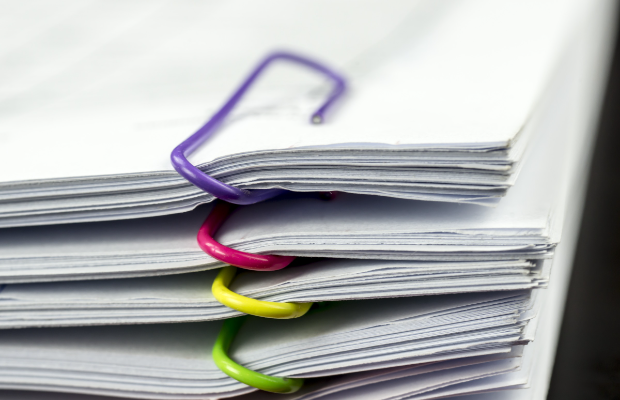When it comes to preparing for a house sale, there are countless documents to get in order before you can even put your home on the market.
Thankfully, a little preparation is all you need, and if you follow this step-by-step guide, you’ll be able to avoid months’ worth of moving stress.
For help with selling your home, find your local branch
The essential documents you need to sell a house
First and foremost, when you decide to put your house on the market, you will need to instruct a conveyancer to represent you. A conveyancer can organise some documents for you, however, most of the paperwork will be up to you to gather. These documents can then be shared with the buyer’s conveyancer, who will then investigate all your documents and raise any necessary questions. The key documents required to sell
a house are:
- Title register & plan documents
- Proof of ownership
- Energy performance certificate (EPC)
- Lease
- Contract for sale & Transfer deed
Title register and plan documents
The two most important documents that you will need to sell your house are the title and register plan. These documents are stored digitally by HM Land Registry, and you will need them for proof that you own the property and details of the terms of how you own it.
For example, if the ownership is shared with other people, or if you used a mortgage to purchase the house – this information is stored on the register. The plan is a map that shows the boundaries of the land, so it’s essential that you purchase a copy of each of these documents from the HM Land Registry website. In order to sell your property, Official Copy Entries will need to be provided, and these can be obtained by your conveyancer.
Proof of ownership
Once you have acquired your title register and plan, you will need to be able to provide evidence that you are the owner of the property. Your conveyancer will need proof of identity that matches all the details of the person named on the title register. If there are other people named on the title, they will also need to provide proof of their identity.
Energy performance certificate (EPC)
It’s vital that your house has a valid energy performance certificate (EPC) in order for you to sell. There would have been an EPC rating when you bought the house, but it may have expired.
You can check if your home has a valid EPC rating through the Gov.uk website. If you find your home’s certificate is still up-to-date, you can store the PDF and send to your conveyancer. If your home does not have a valid EPC, you can arrange for an accredited energy assessor to visit and give you an up-to-date certificate.
Lease (for Leasehold properties only)
If your property is leasehold, you will need to provide a copy of the lease. If registered with HM Land Registry, you will be able to find a copy of the lease on file and your conveyancer can hold this for you and you may want to ask them to review it and spot anything that could cause any queries or delays.
Contract for sale and transfer deed documents
There are a couple of documents that your conveyancer will prepare. While you don’t need to organise these, you will need to check them over and sign them.
A Property Transfer Deed (also known as TR1) is the document that legally transfers the ownership of a house from you to the buyer. The contract for sale includes the details of the buyers, sellers, address, agreed price and any conditions you may have set.
You can ask your conveyancer if they have prepared them.
Property searches
These are the standard inquiries that your conveyancer will make so that they can find out as much information about your house as possible. There are three key searches that will need to take place, these are:
- The local authority search – The local council will be asked for information on issues relating to planning, building control, highway, pollution and more.
- Environmental search – The environment agencies will be asked for information on issues relating to flooding, landslides, subsidence, contaminated land & more.
- Water & Drainage search – this asks the local water company about who owns & maintains sewers, drains & piping, if the property is connected to a public supply and the location of public sewer and drainage pipes.
There are other common searches required – your conveyancer will let you know which ones they deem most likely. Some other common searches are a chancel search, a coal mining search and further investigation into flood risk.
Property information form (TA6)
The property information form (or TA6) is a questionnaire that will provide your buyer
with detailed information about the property. The form may cover things like boundaries, disputes, insurance, utilities and more. Ask your conveyancer for a copy of the TA6, and try to fill out this form as early as possible so that you can predict which additional documents you will need, as some may be dependent on your answers.
Fittings and contents form (TA10)
The Fittings and Contents Form (TA10) allows the seller to identify exactly what is included in and excluded from the overall sale price. Similar to the TA6, get this done as early as possible and have your conveyancer review it for any issues.
Memorandum of sale (MOS)
The memorandum of sale (MOS) is a document that contains all the important details of the property transaction. This is usually prepared by the estate agent, and it will state who the acting conveyancers are, as well as the buyers and sellers. This is used by the conveyancers to enable them to get in contact and start up the process.
Leasehold information form (TA7) and leasehold pack
If the house you are selling is a leasehold, you must provide the leasehold information form (TA7). This document details everything there is to know about the lease, the freeholder, the management company and any other parties involved.
The leasehold pack will be completed by the freehold owner, but you will typically have to pay for this series of documents. They should include an LPE1, a fire risk assessment, insurances, financial accounts and more.
Gas safety certificate
It is not a legal requirement to have a gas safety certificate, but your buyer’s
conveyancer may well request one. Your property’s gas safety certificate should be provided to you by a registered gas safety engineer, once they have installed or serviced any gas appliances.
Electrical safety certificate
Similar to the gas safety certificate, your buyer’s conveyancer is likely to request an electrical safety certificate as well. This will be provided to you by a qualified electrician once they have installed or modified any electrics in the house.
Planning documents
If your property has been modified or renovated since you moved in, you will need to provide the planning documents, including approval and sign-off. You will also likely be asked to provide documents relating to work done before you owned the house, and you can search your local planning portal by using your local authority’s name for these documents.
What other documents do you need to sell a house?
While this list has covered all the basics, the documents you will need will depend on your individual property, and by checking all of the above off your list, you’ll be able to see what remains before completion. Other important documents to sell
a house include insurance policies, surveys, and previous documents from when you purchased the house.
Contact our agents for expert advice on selling your home.







